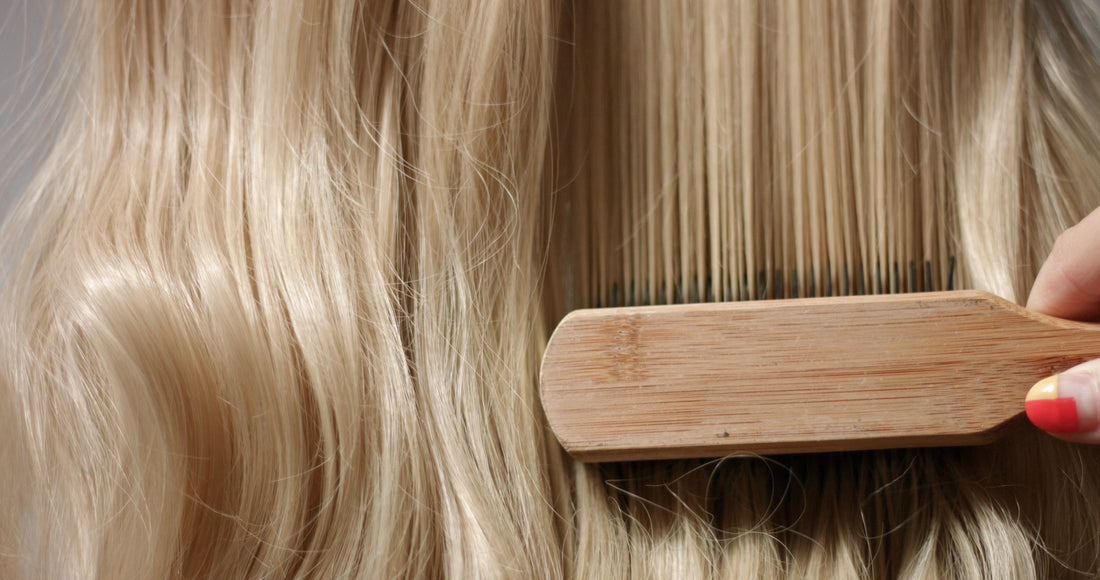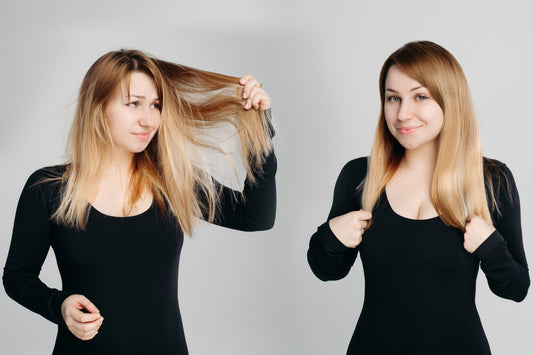Table of Contents
Key Takeaways
- Split ends are caused by factors like heat styling, chemical treatments, and over-washing.
- There are several types of split ends, including double, triple, feathered, tree, and knot splits.
- Identifying split ends is key to preventing further damage to your hair.
- Ignoring split ends can lead to more severe hair damage and breakage.
- Regular trims and proper hair care can help manage and prevent split ends.
What Are Split Ends?
Split ends, also called trichoptilosis, happen when the ends of a hair strand become frayed, split, or even knotted. This damage usually starts at the tips, where the hair is oldest and most exposed. It’s a clear signal that your hair ends are in trouble and need some care.
Split ends don’t just make your hair look messy, they can make styling harder, slow down your growth goals, and even cause more breakage over time. If you want smoother, healthier, more manageable hair, dealing with split ends is non-negotiable.
What Causes Split Ends?
Here’s what contributes to dead ends hair:
Heat Styling
- Frequent use of straighteners, curling irons, and hot blow dryers dehydrates hair.
- High heat breaks down the protein (keratin) in the strand, weakening the structure.
Chemicals & Treatments
- Bleach, hair dye, perms, relaxers, and keratin treatments can weaken the hair shaft.
- Chemical exposure raises the cuticle, exposing inner layers.
Over-Washing
- Washing too often strips the hair’s natural oils, especially with sulfates.
- Dry, unprotected ends are more prone to splitting.
Environmental Stress
- UV rays, pollution, humidity, and cold air damage the cuticle layer.
Harsh Products
- Products with alcohol, sulfates, or strong fragrances can dry out and damage hair.
Mechanical Friction
- Rough brushing, tight hairstyles, towel drying, or friction from clothes and pillowcases creates microtears along the hair shaft.
Types of Split Ends
There’s more than one kind of split end and each one tells a different story about the damage happening to your hair. Recognizing the type of split ends can help in choosing the right treatment.
|
Type |
What It Looks Like |
What It Means |
|
Basic/Double |
A clean “Y” shaped split at the end |
Early-stage damage from heat or dryness |
|
Triple Split |
One end splits into three |
Prolonged damage or lack of trimming |
|
Feathered |
Multiple tiny splits along the strand |
Repeated mechanical or chemical damage |
|
Tree Split |
Branch-like splits going up the hair shaft |
Advanced damage, where cuticle is severely compromised |
|
Knots |
Tiny beads at the ends (common in curls) |
Strands wrap and tangle, often caused by friction or dryness |
Real Talk:
-
Basic splits can often be treated with deep conditioning and oiling.
-
Tree and feather splits need trimming ASAP to prevent the damage from moving up.
- Knots tend to affect curly or coily hair types more, especially if detangling isn’t done carefully.
How to Identify Split Ends
Wondering if you’re looking at split ends or just dry hair?
Split Ends:
- Look like a frayed rope or fork
- Feel coarse or brittle at the tips
- Often create tangles at the ends
- Look lighter or thinner at the tips
Healthy Ends:
- Feel smooth to the touch
- No fraying or unevenness
- Easier to detangle and style
You can also twist a section of your hair tightly, split ends hair will poke out as fuzzy, broken pieces along the twist.
What Happens If You Ignore Split Ends?
Split ends won’t just stay at the tips, they travel up the strand over time, causing:
- Breakage higher up the shaft
- Thinning and loss of hair length
- More frizz and tangles
- Dull-looking hair that’s hard to style
- Slower “growth” due to constant breakage
Ignoring hair split ends is like ignoring a chipped windshield. It only gets worse!
How to Fix Split Ends
Split ends can’t actually be repaired. Once the strand is split, only trimming removes the damage. But you can minimize the appearance and stop them from getting worse.
DIY Fixes
- Trim regularly: Every 6–8 weeks, even if it's just a micro-trim.
- Oils: Coconut, argan, jojoba, or olive oil nourish and seal ends.
- Deep conditioning: Once a week to strengthen and hydrate.
- Leave-in conditioners or serums: Form a temporary barrier and smooth split ends hair.
- Protein treatments: Strengthen weakened hair and rebuild structure.
- Papaya Hair Mask: Rich in amino acids that help repair split ends.
- Banana Hair Mask: May help nourish and moisturize hair, reducing split ends.
Try the Split Ender Pro
The Split Ender Pro is a unique trimming tool that removes just the damaged ends, keeping your length intact. Unlike scissors, it targets only split ends without cutting healthy strands.
According to PubMed, maintaining the cuticle layer through gentle care and regular trimming is essential to long-term hair health.
How to Prevent Split Ends
Prevention is always better than cure. Here’s how to stop hair split ends before they start:
- Use heat protectant before any hot tools
- Sleep on a silk or satin pillowcase
- Gently detangle hair with a wide-tooth comb
- Avoid brushing wet hair, use a conditioner-based detangler instead
- Limit chemical treatments or space them out
- Apply oils or serums to the ends regularly
- Eat a diet rich in protein, iron, and omega-3s
- Stay hydrated! Your hair needs moisture from the inside too
When to See a Pro
If your hair feels:
- Stringy, gummy, or mushy when wet
- Frizzy no matter how much product you use
- Full of split ends shortly after trimming
…it’s time to visit a stylist. A professional trim and deep treatment can reset your hair and remove dead ends hair properly. They may also recommend salon-quality protein or bond-building treatments.
If you’re between salon visits and want to keep split ends under control at home, a tool like the Split Ender Pro can help maintain healthy ends without losing length.
Quiz: Do You Have Split Ends?
Take this short quiz to find out
-
Do your ends feel rough or snaggy?
-
Have you noticed “Y” or “feather” shapes at the tips?
-
Does your brush or comb pull more at the ends?
-
Do you use heat tools more than twice a week?
-
Has it been more than two months since your last trim?
Results:
- 0–1 Yes: You’re good! Just maintain your routine.
- 2–3 Yes: You’re at risk! Add some moisture and trim soon.
- 4–5 Yes: Split ends are definitely happening. Time for TLC and maybe the Split Ender Pro!
Recap
Split ends might seem small, but they can create major hair problems if ignored. Let’s wrap it all up:
- Split ends hair happens when your hair’s outer layer is worn down.
- There are several types of split ends and each one tells a story about damage.
- You can treat them with oils, conditioners, or the Split Ender Pro.
- Prevent them with good habits like heat protection, hydration, and regular trims.
- Don’t wait too long! dead ends hair only gets worse if ignored.
Sources:
Frequently Asked Questions
What are split ends?
Split ends happen when the tips of your hair get damaged and start to fray or split apart. This usually occurs at the end of the hair strands.
What causes split ends?
Split ends can be caused by many things, like using heat tools too much, harsh chemicals, washing your hair too often, and even rough towel drying.
How can I tell if I have split ends?
You can spot split ends by looking for hair strands that look frayed or have a Y-shape at the end. Healthy hair tips look smooth and intact.
Are split ends harmful?
Yes, split ends are harmful because they can make your hair look unhealthy and can lead to more breakage if not taken care of.
Can split ends be fixed?
Once hair is split, it can't be repaired. The best way to deal with split ends is to trim them off. The Split Ender Pro is great to help maintain smooth, healthy-looking hair by trimming split ends without sacrificing length.
How can I prevent split ends?
To prevent split ends, avoid excessive heat styling, use conditioner, and be gentle when brushing your hair, especially when it’s wet.
When should I see a professional about my split ends?
If your split ends are severe or you notice a lot of breakage, it’s a good idea to see a hairstylist for a trim and professional advice.
What are some home remedies for split ends?
You can use oils like coconut or argan oil, deep conditioners, and leave-in treatments to help keep your hair moisturized and reduce the appearance of split ends.




